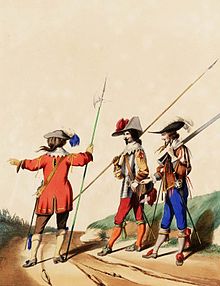Siege of Saint-Jean-d'Angély
| date | May 30th to June 24th 1621 |
|---|---|
| place | Saint-Jean-d'Angély |
| output | Victory of the besiegers |
| Parties to the conflict | |
|---|---|
| Commander | |
|
|
|
Montauban - Montpellier - La Rochelle (1573) - La Rochelle (1627–1628) - Royan - Saint-Antonin - Saint-Jean-d'Angély
The siege of Saint-Jean-d'Angély was carried out in 1621 by troops of King Louis XIII. carried out and were part of the actions to suppress the Huguenot uprising and the inevitable conquest of the Huguenot bastions.
prehistory
Despite the negative attitude of Louis XIII. the General Assembly of the Reformed Church met in La Rochelle, protested on May 18, 1621 against the renewed disregard of the Edict of Nantes and prepared for war.
The République Protestante (Protestant Republic) was divided into eight districts, each with its own provincial council, its own finances, its own army and its own commander.
Some provinces refused to participate in a war and there were serious differences of opinion among the leaders.
Henri III de La Trémoille wanted Angoumois not put on the game, Lesdiguières wanted the Dauphiné stay out of the conflict, much like Charles de Lorraine, duc de Guise , the Provence , as Gaspard de Coligny , who, after Aigues-Mortes withdrew. However, there were also enthusiastic supporters of the uprising, for example in Montauban , Bergerac , Nîmes , Uzès and of course in La Rochelle .
The army of the King of France marched on Saint-Jean-d'Angély , where Benjamin de Rohan's refusal to open the gates signaled the start of the rebellion. Louis XIII. decided to take the city absolutely, as it was a strategic position to control the Huguenot bastion of La Rochelle and was essential for the blockade of La Rochelle .
The King's Army
Regiments:
infantry
- Regiment du Bourg de Lespinasse
- Regiment de Chappes
- Regiment de Champagne
- Regiment de Chastellier-Barlot
- Regiment d'Estissac
- French Garde Regiment
- Régiment des Gardes suisses
- Régiment de Lauzières (also called Régiment de Thémines)
- Regiment de Lauzun
- Regiment de Navarre
- Regiment de Normandy
- Picardy Regiment
- Regiment de Piémont
- Regiment de Puyserguier
- Regiment de Rambures
- Regiment de Saint-Luc
- Regiment de Saint-Vivian
- Regiment de Saint-Vincent
- Regiment de Soyecourt
Cavalry (7 Cornettes )
- Carabins d'Esplans
- Chevau-Legers de Chateaubriant
- Chevau Legers de la Garde
- Chevau-Legers de Guise
- Chevau-Legers de la Reine
- Gendarme de la garde
- Regiment de Brissac cavalerie
The siege
On May 31, the "Régiment de Champagne" launched a massive assault on the suburb of Taillebourg in vain. It lost its Mestre de camp Charles-François de la Baume, marquis de Montrevel , three Capitaines and a large number of men.
The king decided now to start the formal siege. The construction of the approach trenches was so dangerous that the peasants forcibly dug it up preferred to run away. For this reason it had to be taken over by soldiers to whom the king paid a premium , as in the siege of Amiens .
Two attack columns were formed:
- “Régiment des Gardes françaises” and the “Gardes suisses”, commanded by Marshals Charles II. De Cossé, duc de Brissac and Charles de Choiseul, marquis de Praslin , with the Maréchal de camp Charles II. De Créquy , Timoléon d'Espinay de Saint-Luc and François de Bassompierre .
- “Régiment de Picardie”, commanded by Honoré d'Albert , Mestre de camp of the “Régiment de Normandie”, assisted by de Termes and François V de La Rochefoucauld .
On June 10, the attack force was reinforced by the "Régiment du Bourg de Lespinasse". On June 14, the besieged made a sortie, but this was repulsed by the regiments "du Bourg de Lespinasse" and "d'Estissac".
Although Bassompierre had four trusses completed in his attack section by June 23, the losses were still very high. Wounded were the officers: de Favoles, de Carbonnier, des Erables, de La Valette , the Baron de Palluau ...
On June 24th, the two regiments of the guards, supported by the regiments “Navarre” and “Rambures”, launched another attack on the bastion “Tour Blanche”. Charles de Créquy received a shot in the cheek from a musket .
consequences
On the evening of June 24th, de Rohan capitulated after only 26 days of siege. He received free withdrawal after swearing to the king not to take up arms against him. He did not keep this oath , however, as he took over tasks in the fortress on August 7th during the blockade of La Rochelle.
The taking of the place came to Louis XIII. to be expensive. In addition to the dead and injured of the troops, he also had to mourn the loss of senior officers, such as the Maréchal de Brissac , who had fallen ill during the siege and died in June.
Louis XIII. left a small army to block La Rochelle and moved south with its main force to the unsuccessful siege of Montauban .
Individual evidence
- ↑ Batailles françaises par le colonel Édouard Hardy de Périni volume 3 (1621–1643)
- ↑ Stéphane Thion: Les armées françaises de la guerre de trente ans
literature
- Colonel Edouard Hardy de Périni, Batailles françaises
- La prize de la ville de Sainct Jean d'Angely rendue à l'obeyssance du Roy le 25 juin 1621, où sont, descrites les particularitez, et la clemence de sa Majesté en la reddition d'icelle en ligne sur Gallica

